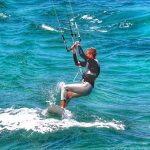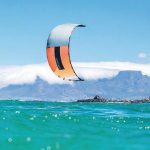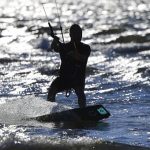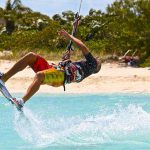Using a Trainer Kite to Learn to Kiteboard
A trainer kite is the most cost-effective method of getting into kiteboarding for 2 reasons:
If you take a kitesurfing lesson, you will improve much more quickly. Lessons cost between $50 and $100 per hour. Once you have learned how to fly a kite, your instructor will be able to teach you how to kiteboard using a larger kite.
It is better to save your new kitesurfing gear from unnecessary wear and tear during your first days of learning to ride, so that you don’t have to spend as much money replacing it.
You will learn much faster if you spend 4-10 hours flying a trainer kite before your first lesson. This is because 80% of kiteboarding is kite flying.
If you can master flying the kite, you will be less likely to crash it into the water. Snowkiting and land kiting can be learned quickly, but water kiting takes much longer. A trainer kite is a good place to start.
Basic Flying
Which is the better spot to fly your kite, a small field in the city or a frozen lake? If you want your kite to fly properly, you should avoid flying it in a small field in the city because there are often trees or buildings between you and the wind.
Frozen lakes work excellent, but you will need to walk a little way into the center.
Take the trainer kite out of its bag and lay it on the ground with the bridle lines facing up and the trailing edge facing the wind.Remove any knots or tangles from the lines, then hold the kite up into the wind and walk forward to launch it.
To get the kite to launch, you need to pull firmly on the bar. It’s just like riding a bicycle; if you want the kite to turn left, you pull the bar to the left, and if you want the kite to turn right, you pull the bar to the right.
Things to remember
- You will crash your trainer kite! Just walk over and set it back up for re-launch. Try not to crash it directly downwind as it is possible to blow seams out of a kite if crashed directly into the ground at 50 miles per hour. Yes, they can move that fast.
- The wind is like a road; sometimes it’s bumpy and sometimes it’s smooth. Your kite may behave well one day and fly the next. Most likely the wind is much different.
- Be careful in high winds. Even small trainer kites develop a lot of power. Our favorite trainer, the 3.6-meter Beamer, will allow a 200lb person to jump 6-10 feet forward when the winds are over 18mph. Always leave yourself room for evasive action (3-5 line lengths).
- If you have someone helping you launch the trainer kite, make sure they move immediately after launching. Also, be nice and share your kite with them.
- It takes most people anywhere from ½ hour to 3 hours to learn to fly a trainer kite proficiently. Don’t expect to be a great flier in 5 minutes.
- Twists in the lines. All kites will still fly the same even with a twist in their lines. To untwist the lines, either fly a complete loop in the other direction or spin your body quickly around. Most kites can fly with 2 or 3 loops before the lines begin to bind up.
Techniques to improve kiteboarding skills
Power Stroke
The power stroke is the key to riding a wakeboard. The goal of these motions is to develop your muscle memory of turning the kite around before crashing on the land or water.
As you work on the power stroke, try to keep your center of gravity behind your feet and not get pulled forward into a running position. You should slide forward on your feet.
Take your trainer kite to the noon position in the wind window. Fly the kite down to the 3 o’clock position and then fly directly back to the noon position. Now move the kite to the 11 o’clock position and fly to 3 o’clock.
Now work on doing this from noon to 9 and 1 to 9. You need to be able to fly the power stroke with confidence, in both directions, without thinking about turning the kite back up in the sky.
Now that you can fly the power stroke while keeping your feet under you it’s time to.
Practice your board starts
This text is about how to position your legs and hips when getting on your board, in order to point the board downwind.
To ride to your right side, put your kite in neutral (hovering straight above your head) and sit down on the ground. Extend your right leg forward and bend your left leg in a little bit, then send the trainer kite into a power stroke toward your right side.
You should be able to stand up on your right foot with your body turned at about a 45-degree angle to the wind.
One of the number one problems for new kiteboarders is not keeping their kiteboards pointed downwind when attempting a water start. If you move your trainer kite to the 1 o’clock position, you will be able to generate more power since your hips and body will be pointing downwind.
Now work on your left side.
If you want to learn how to snowboard or land a plane, make sure to use the same technique of pointing the board or plane downwind.
Make use of the wind you are generating to help you with any of the vehicles listed above. Don’t forget to wear protective gear like padding and a helmet.
Add a harness and bar loop.
A trainer kite is most effective when used with a harness and a fixed loop on the bar. This allows the user to practice flying while being “hooked in” and work on kite control with one hand. This is a skill that is necessary for learning to kite in the water.
The user will need to fly one-handed while carrying their board to the water and trying to put it on their feet.
With the kite in the air, all you need to do is keep your kite flying steady, and you can ride around on your board all day. The added loop and harness give you the ability to snow or land kite for an extended period of time. All you need to do to keep riding is keep the kite flying steadily.
How to Try to Avoid Lofting
The following precautions have been assembled to reduce the chance of lofting. Input from kiteboarders who have been lofted is welcome. Information on lofting and the means of avoiding it is still coming in.
- Pick your weather carefully and if it looks like it is going to change for the worse, come in promptly. The wind can gust suddenly with a very little warning before a squall. If the weather radar and wind plots imply squalls or unduly gusty weather in your area or if obvious storm clouds or other signs of unstable weather are moving in, don’t go kiteboarding.
If you are already out and squalls are moving in, come in early and unrig well in advance of the storm. You should be onshore with your kite adequately anchored before either the wind or temperature changes.
When in doubt, don’t fly, wait for stable weather. Squall-induced wind gusts are the most common cause of lofting.
- If you are on land or near hard objects such as rocks, boats, shallow water, or other people, try to keep your kite at the edge of the wind window and near the surface.
Get offshore without delay., NEVER LEAVE YOUR KITE NEAR THE ZENITH OR THE VERTICAL WHILE ON LAND OR NEAR HARD OBJECTS. When near hard objects, keep your kite low and near the surface. “Near” may mean within 100 ft. (30 m) or even further from the hard objects.
Of course, if you are hit by a strong gust with your kite low, you may be violently dragged as opposed to lofted, so plan accordingly. Be ready to depower your kite at the earliest opportunity if hit by a strong gust to try to avoid extended dragging and potentially serious injury.
If you are hit by a strong enough gust it may pop your kite up into the center of the power zone from near the ground. The trick is to not make yourself vulnerable to violent squally weather in the first place.
- If you are near hard objects or if pronounced gusty conditions are developing, stay unhooked and be prepared to let go of your bar. It is also a good idea not to snap shackles to your bar under these conditions.
To be able to hold your kite bar, it may be necessary for you to pull in on your trimming strap or line to depower your kite until you are safely offshore. It may also be necessary for you to rig down in kite size to be able to manage the depowered kite without connecting to the chicken or centerline loop.
If you are using a snap shackle, it must be rigged properly to improve the reliability of the release. A metal ring or shackle should connect the snap shackle to the chicken or centerline loop. Under no conditions should the shackle be directly connected to the chicken or centerline loop.
A center release snap shackle may provide a more reliable release under the kind of tremendous loading that comes with lofting. If you do use a snap shackle, rehearse mentally, frequently, ” if I get lofted, pull the snap shackle release cord”. In the shock of lofting, your reactions may be slow, so rehearsing may help.
Of course, if you are already high over land, this one is a very tough judgment call as riding things out may be the wiser course. To avoid having to make such critical decisions in very little time, which may result in injury regardless of the decision, the best course is to work hard to avoid circumstances that may lead to lofting in the first place.
- Always carefully and methodically preflight your kiteboarding gear. If you are launching at higher wind speeds, say 20 kts. or more, if your lines are uneven or your gear is otherwise not correct at launch you can be lofted very rapidly.
The speed can be so great that you have insufficient time to react to correct the situation. If you aren’t attached to your bar you can simply let go and defuse the situation.
- Avoid or simply don’t fly with onshore winds or kiteboard within 300 ft.(100 m), upwind of hard objects. If you go out in onshore winds, which is NOT RECOMMENDED, kiteboard more than 300 ft. . (100 m), offshore until it is time to come in.
Come in without delay, keeping the kite low, and be prepared to let go of your bar if lofted. This technique generally requires assisted landings shortly after you make it to shore.
Do not jump within 300 ft. . (100 m), of shore or hard downwind objects. If feasible it would be a good idea to have assisted launches and landings at least 200 feet, (60 m), offshore in onshore winds if the water is shallow enough.
- Be particularly cautious while upwind of bystanders and hard objects. If circumstances seem to support possible lofting, it would be best not to launch at all.
If the rider decides to go despite this recommendation and prudence, he should move a substantial distance (300 ft. or more), away from the bystanders.
- Try to use shorter line sets if you are expecting stronger winds. Also do not fly a larger kite than supported by the probable conditions.
Make sure your kite depower system COMPLETELY depowers your kite and will not break under normal loading.
- Always wear a good well padded, close-fitting, and light helmet! Wearing an impact vest is also a good idea.
- Do not come within 100′ of substantial vertical surfaces or walls with onshore winds to avoid potentially being lifted in the slipstream that runs up the face of the vertical surface. In theory, even relatively minor winds could cause substantial uplift along the face of buildings, cliffs, hills, etc.



